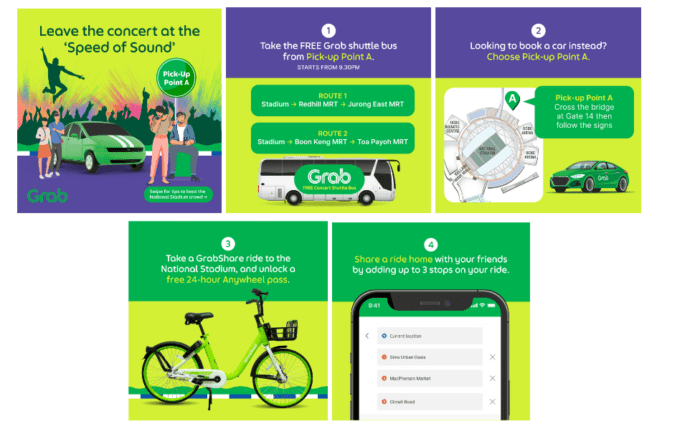When organisers plan mega-events like Coldplay concerts at Singapore’s National Stadium recently, their aim is to deliver the perfect show. Meanwhile, we at Grab focus on the “before” and “after” experiences of the main event. What happens when some 55,000 fans arrive and depart at roughly the same time? What are the best routes to get people to and from the stadium? How can drivers best navigate the traffic?
After all, an event can become memorable for the wrong reasons. An extreme case would be when Philippine fans missed the Bruno Mars concert because of heavy traffic.
Grab’s geo-location team takes such events seriously. We go the extra mile to make sure there are enough Grab driver-partners at venues, and that they can execute their pick-ups and drop-offs without a hitch. There are a few things we’ve learned over time. For instance, from last year’s Formula 1 (F1) race. It included large-scale road closures in key areas and limited access to certain pick-up and drop-off points, which made it even more challenging than a music event. We keep refining our approach based on some core principles.
Ensuring a smooth ride at mega-events
It’s important to us to create a hassle-free event experience not just for passengers, but also for Grab’s driver-partners. We do this by making sure that our maps reliably direct driver-partners to the particular spots where passenger pick-ups and drop-offs are allowed. This makes it more efficient for passengers and driver-partners to find each other.
Using our geofencing technology, we draw virtual perimeters (a.k.a. fences) around these zones as precisely as possible, by pinpointing the latitude and longitude coordinates of Grab entry points. We supplement our mapping data with hyperlocal area knowledge and information supplied by event organisers.
Some people, however, prefer to find their ride at nearby landmarks instead of at the pick-up points chosen by event organisers. By walking a few blocks to a point of interest (POI) like a hotel or cafe, they can easily meet up with their friends, avoid long passenger queues, and steer clear of heavy traffic around the event venue. Having observed this behaviour during F1 races, we’ve made it a point to also highlight such POIs using our hyperlocalised maps.
The driver interface on the Grab app displays areas where many passengers are searching for rides, allowing driver-partners to go where demand is high. Driver-partners save time, as they find customers more quickly by anticipating demand.
Communication is key
Feature deployment is only part of the solution. User empowerment is key—passengers need to know that these features exist and understand how to use them. For example, informing passengers about the appropriate pick-ups and drop-offs and supporting driver-partners with data on expected demand, can shape the overall experience of the event.
We also coordinate with event organisers and transport authorities months in advance and on the event day itself, to get a heads-up on road closures and other mobility restrictions that might affect operations. We update our maps and algorithms accordingly so our driver-partners don’t get lost.
In the days leading up to the F1 race, we deployed a comprehensive communications strategy that included in-app updates, push notifications, SMS, and social media announcements about road closures and amended drop-off and pick-up points.
The same goes for the recent Coldplay concerts. We are putting communication at the forefront of our strategy, consistently communicating to both driver-partners and users. We’re also offering various transportation options and running marketing campaigns to educate concert-goers on how to find these rides.

How Grab learned to love events
The solutions we’re deploying during the Coldplay concerts reflect the way we’ve come to see mega-events at Grab. We approach them as we would any large scale geolocation management challenge—with product innovation, engineering efficiency, systemic design, hyperlocal knowledge, and an emphasis on the user experience. Therefore, when F1 rolls around again, or another major music act comes to town, it is a regular season at Grab, not an exceptional circumstance.
Grab’s core strengths of established map operations in Southeast Asia and the sharp talent of our product and engineering teams play crucial roles in addressing the unique challenges of any event. We are getting smarter at managing events that attract tens to hundreds of thousands of people.
3 Media Close,
Singapore 138498
Komsan Chiyadis
GrabFood delivery-partner, Thailand
COVID-19 has dealt an unprecedented blow to the tourism industry, affecting the livelihoods of millions of workers. One of them was Komsan, an assistant chef in a luxury hotel based in the Srinakarin area.
As the number of tourists at the hotel plunged, he decided to sign up as a GrabFood delivery-partner to earn an alternative income. Soon after, the hotel ceased operations.
Komsan has viewed this change through an optimistic lens, calling it the perfect opportunity for him to embark on a fresh journey after his previous job. Aside from GrabFood deliveries, he now also picks up GrabExpress jobs. It can get tiring, having to shuttle between different locations, but Komsan finds it exciting. And mostly, he’s glad to get his income back on track.

